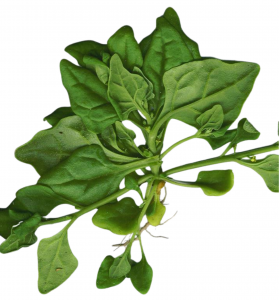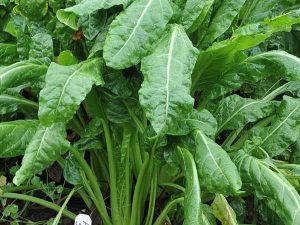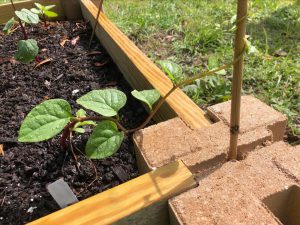New Zealand spinach has a mild flavor, flourishes in the heat, and can serve as a nutritious summer salad. Photo by Forest and Kim Starr.
If you’ve ever tried growing lettuce (Lactuca sativa), true spinach (Spinacia oleracea), or crops in the cabbage family (Brassica spp.) in late spring or summer in the subtropics of Florida, you know that our extreme heat can make it difficult. Between bolting leaves, fungal diseases, insect pressure, and poor germination, it can be quite a challenge to keep greens on the dinner table all year long.
Fortunately, there are a few greens that – while less well known – can take our Florida heat and are relatively easy to grow. Some of these greens include New Zealand spinach, Malabar spinach, and perpetual spinach. They are frost sensitive and prefer well-drained, slightly acidic soil and require regular watering, but they don’t need a lot of fertilizer or special attention. Additionally, they are resistant to most pests and diseases.
New Zealand Spinach

New Zealand spinach tastes similar to true spinach but can stand up to the Florida heat. Photo by Forest and Kim Starr, Starr Environmental, Bugwood.org.
New Zealand spinach (Tetragonia tetragonioides) is a leafy green that is native to New Zealand, but it is well-adapted to warm climates such as ours. It grows one to two feet in height and branches two to three feet across. In the kitchen, it is known for its mild, slightly salty flavor, and it is a great source of vitamins A and C, iron, and calcium.
New Zealand spinach germinates slowly, taking two to three weeks to sprout. Soaking seeds for 24 hours directly before planting can help them along, but be patient, and keep the planted area weed free.
Sow seeds a quarter-inch deep, two inches apart, and water well, keeping the soil moist but not waterlogged. Once germinated, thin to eight to 12 inches apart. After the plant has grown about a foot, harvest a few tender leaves off of each branch, making sure enough leaves remain so the plant can continue to photosynthesize and grow.
Read the UF/IFAS publication Spinach, New Zealand to learn more about growing New Zealand spinach.
Malabar Spinach
Malabar spinach (Basella alba and B. cordifolia) is a fast-growing leafy vine native to tropical South Asia. It is known for its thick, succulent leaves and its slightly lemony flavor. It is a good source of antioxidants, vitamins A and C, iron, and calcium.
Like New Zealand spinach, Malabar spinach is vulnerable to frosts and grows well in hot, humid conditions. Wait until soil temperatures reach 65°F to 75°F to sow or wait at least three weeks after the last frost date. Typically, in our area, it does best sown from mid-April through early June.
Sow seeds a quarter-inch deep, two inches apart. Also, like New Zealand spinach, Malabar spinach can take two to three weeks to germinate, so soaking seeds for 24 hours prior to planting is recommended. Once planted, keep the area weed free and well-watered, but not waterlogged.
After germination, thin the sprouts out so that they are spaced 12 inches apart. In optimal conditions, the plant can reach maturity in 70 days. Vines will continue to grow to 10 feet or longer and will benefit from a trellis, a fence, or stakes to assist in climbing. Harvest the leaves and young stems and prune back any overlong vines.
Read the UF/IFAS publication Florida Cultivation Guide for Malabar Spinach to learn more about growing Malabar spinach.
Perpetual Spinach

Perpetual spinach is related to Swiss chard and beets, but it is more “spinach-like” in flavor. Photo by Baker Creek Heirloom Seed Company.
Perpetual spinach (Beta vulgaris), or spinach beet, is a leafy green that is the same species as Swiss chard and beets, but tastes more like a true spinach and is known for its mild, slightly sweet flavor. It is a great source of vitamins A, C, and K, as well as calcium, magnesium, and iron.
Perpetual spinach can tolerate cooler temperatures than New Zealand and Malabar spinach, but it also grows well in warm weather and can continue to produce throughout the growing season.
Sow seeds a half-inch inch deep, two inches apart. Water well and keep the soil moist but not waterlogged. Again, be patient, as like the other heat-loving greens, perpetual spinach can take up to two to three weeks to germinate.
Once the plants have sprouted, thin them out so that they are spaced six to eight inches apart. Begin harvesting by cutting leaves at the base of the stem. If the plants get too big or the leaves begin to taste bitter, cut the leaves back to about three inches above the soil and they will produce new, tender leaves.
Learn more about perpetual spinach through the NC State Extension’s Beta vulgaris Plant Toolbox page or the University of Hawaii fact sheet Perpetual Spinach (Beta vulgaris L. Cicla group).
While these heat-loving greens do not taste the same as lettuce, true spinach, kale, or collards, they are incredibly versatile in the kitchen and have a unique flavor profile. They can be eaten raw in salads, or they can be cooked in a variety of dishes. For example, New Zealand spinach can be sautéed with garlic and lemon juice, while Malabar spinach can be used as a green in a delicious stir-fry. Perpetual spinach can be used in soups, stews, casseroles, and salads.
Other heat-loving greens to try out in the garden include Okinawa spinach (Gynura crepioides), longevity spinach (Gynura procumbens), and Surinam spinach (Talinum triangulare).
If you are looking to keep homegrown greens on the dinner table this spring and summer, give heat-loving greens a try! They are easy to grow, resistant to pests and diseases, and are great additions to many dishes.
- Dung Beetles of the Florida Panhandle - June 26, 2025
- Summer Veggies That Can Take The Heat - May 15, 2025
- Stopping Tomato Blossom-End Rot Before It Starts - April 3, 2025


